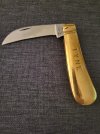You are using an out of date browser. It may not display this or other websites correctly.
You should upgrade or use an alternative browser.
You should upgrade or use an alternative browser.
The Peach Pruner!!
- Thread starter waynorth
- Start date
Will Power
Gold Member
- Joined
- Jan 18, 2007
- Messages
- 31,521
Pruning knives have long been superseded by secateurs, this probably started in countries such as France where viticulture is a major sector in agriculture and the need for rapid, efficient and clean pruning was a must. Secateur use spread rapidly and into horticulture/gardening. In northern climes such as England where the knife term appears have originated, Peaches were grown in large gardens against South wall or in glasshouses, unlike Apples etc they need particular and delicate pruning and only in spring not winter . Peach fruits on one year old wood so the old stuff must be removed once the basic form of the tree is established, many wall trained trees were in a fan or espalier fashion.
A Peach Pruner or any Pruner is useful for removing excess leaves as you suggest or as a way of taking cuttings particularly of semi hard shrubs, useful too for vegetable harvesting so it's still an ally for the gardener for many other asks even if the secateur has displaced it for serious work. Above all it is an 'ally' of the knife collector, being compact and aesthetic, even eccentric
Here's one that arrived in the New Year in Oak and very nicely finished & put together too.

Campbellclanman
Platinum Member
- Joined
- Mar 10, 2007
- Messages
- 14,577
Charlie and Will, of course you guys are on the trail of being correct, my theory is for a home body user and not a commercial use - I doubt a Cutler firm would produce a specific pattern just for the homebody, but rather the greater percentage of use commercially.
Interesting as always!
Interesting as always!
Will Power
Gold Member
- Joined
- Jan 18, 2007
- Messages
- 31,521
While this is not a Peach Pruner, it is small and a distinct horticultural tool- Budding/Grafting knife. For taking hardwood and other cuttings and then inserting them into the rootstock of a different variety for cultivation-propagation purposes. You might want the root vigour of one variety of plant and the dwarf or compact character, colour, fruiting of another. These type of knives are still very much in use with gardeners or breeders of trees, shrubs etc.
This particular one was very kindly sent to me as an unexpected gift from W Way-Barney last week. The construction is of interest: one piece composite handle where the liners/spring are inserted into, the end of the knife is narrowed spatula fashion for use as a 'probe' for inserting a bud or cutting into a rootstock or grafting it onto another plant, can also be used to smear compound around the wound of the plant. It has brass liners and a tapered back spring, white metal non ferric pins and the characteric short blade with a swedge too! Blade is stamped SAYNOR and the tang SAYNOR COOKE & RIDAL. The other side of the tang carries OBTAIN SHEFFIELD ENGLAND. Some Budding knives were only sharpened one side chisel style but this one is double edge (or became..) rather soft carbon steel that readily takes a keen edge-very much needed for the work it is meant for.

This particular one was very kindly sent to me as an unexpected gift from W Way-Barney last week. The construction is of interest: one piece composite handle where the liners/spring are inserted into, the end of the knife is narrowed spatula fashion for use as a 'probe' for inserting a bud or cutting into a rootstock or grafting it onto another plant, can also be used to smear compound around the wound of the plant. It has brass liners and a tapered back spring, white metal non ferric pins and the characteric short blade with a swedge too! Blade is stamped SAYNOR and the tang SAYNOR COOKE & RIDAL. The other side of the tang carries OBTAIN SHEFFIELD ENGLAND. Some Budding knives were only sharpened one side chisel style but this one is double edge (or became..) rather soft carbon steel that readily takes a keen edge-very much needed for the work it is meant for.

Will Power
Gold Member
- Joined
- Jan 18, 2007
- Messages
- 31,521
waynorth
Dealer / Materials Provider
- Joined
- Nov 19, 2005
- Messages
- 30,165
I brought this post forward from our esteemed colleague, Will, because it addresses my question from above, in post number 57!!Naming is indeed a hazardous gameCompanies may call a pattern something because it might sound more attractive and thus get accepted, then a tradition is born...My guesses on Peach Pruner are based on the assumption that Peach is a universally liked fruit, delicate and a bit more alluring sounding than plain Jane Apple or Pear. But then there's Medlar-tricky, Quince, Gage etc
Peaches were not I believe really native to Britain but were popular greenhouse subjects in the large country houses of two centuries ago. Quite a vigorous tree and naming a knife after it-as shown by Duncan in the old catalogue reprints-would lend it some cachet. Knives would be useful for thining out bunches to increase the size of the remaining peaches , so a slender curved blade would be useful here. Also a thinner slender blade is handy for grafting-again something which c19th fruit breeders were keen on to produce new varieties. There was a practice in orchards and fruit growing known as bark-ringing, whereby a thin band of bark was removed from the base of maturer trees. This was to curb unwanted vigour and allegedly increase fruiting. The practice fell out of favour I believe, due to the spread of fungal diseases or even if done improperly, the death of the tree
But here again, a pointy curved blade would be ideal for these purposes, walking around a tree. Pruners are also a great asset for harvesting many kinds of veg in the kitchen-garden.
So, I concur with Charlie, it's a more slender/sleeker version of the Pruner on a Swayback frame and yes, Peach Pruner sounds the partIt appears to be essentially an English pattern. Here's a picture of a Wright Ettrick with a similar Ablett that clearly has the pointy curved blade of a Pruner rather than the straight Wharncliffe

Edited to add: I see you've already done the same,
- Joined
- Dec 2, 2005
- Messages
- 65,563
Tell me about it!I have had difficulty finding a factual history concerning the word Tyne on this knife.View attachment 2474732


In my original thread, I had wondered if there might have originally been a connection to Tyne Foods, which were once huge here. When I mentioned this theory to Stan Shaw, he reacted as if I was stating the blindingly obvious!



Rufus1949
Gold Member
- Joined
- Aug 22, 2021
- Messages
- 12,182
Thanks kindly for taking the time formulating your response Jack.Tell me about it!I've spent years on that one (and read a certain amount of rubbish while doing so)!
I posted a thread on the subject, some years ago, but I expect the photos are missing, I'll see if I can find it - https://www.bladeforums.com/threads/the-tyne-knife.1168960/ I think Tyne knives are also mentioned in an article I did for Knife magazine, with my friend H herder

In my original thread, I had wondered if there might have originally been a connection to Tyne Foods, which were once huge here. When I mentioned this theory to Stan Shaw, he reacted as if I was stating the blindingly obvious!

- Joined
- Dec 2, 2005
- Messages
- 65,563
No trouble Bob, unfortunately there was a time when many important things (and even more unimportant things) didn't get photographed, and recorded online...Thanks kindly for taking the time formulating your response Jack.
Tyne Brand started out canning herrings, and had a once iconic, (but somewhat ugly) factory on the quayside. They commonly gave away gifts to customers, who I assume collected labels or something. I'll PM you something

Rufus1949
Gold Member
- Joined
- Aug 22, 2021
- Messages
- 12,182
Thank you, very kind. No hurry, your health should come first.No trouble Bob, unfortunately there was a time when many important things (and even more unimportant things) didn't get photographed, and recorded online...

Tyne Brand started out canning herrings, and had a once iconic, (but somewhat ugly) factory on the quayside. They commonly gave away gifts to customers, who I assume collected labels or something. I'll PM you something
- Joined
- Dec 2, 2005
- Messages
- 65,563
Thanks Bob, just like having a mild fluThank you, very kind. No hurry, your health should come first.

Will Power
Gold Member
- Joined
- Jan 18, 2007
- Messages
- 31,521
This image is borrowed from another forum and was posted in 2011, the poster was also active here at one time but not now for many years. He had considerable knowledge . (smiling-knife)
He states that the catalogue is from the 1960s, the range of knives look much older but perhaps archaic catalogues were re-issued and not up-dated. Interestingly, the TYNE knife is shown as being part of the general catalogue. Other variant Pruners and horticulture knives shown, the Lino Knife has a pronounced 'beak' to it.
The Oxford Dictionary (1933) lists Tine/Tyne as an obsolete word used as a verb to close/shut something.

He states that the catalogue is from the 1960s, the range of knives look much older but perhaps archaic catalogues were re-issued and not up-dated. Interestingly, the TYNE knife is shown as being part of the general catalogue. Other variant Pruners and horticulture knives shown, the Lino Knife has a pronounced 'beak' to it.
The Oxford Dictionary (1933) lists Tine/Tyne as an obsolete word used as a verb to close/shut something.

Rufus1949
Gold Member
- Joined
- Aug 22, 2021
- Messages
- 12,182
Will,This image is borrowed from another forum and was posted in 2011, the poster was also active here at one time but not now for many years. He had considerable knowledge . (smiling-knife)
He states that the catalogue is from the 1960s, the range of knives look much older but perhaps archaic catalogues were re-issued and not up-dated. Interestingly, the TYNE knife is shown as being part of the general catalogue. Other variant Pruners and horticulture knives shown, the Lino Knife has a pronounced 'beak' to it.
The Oxford Dictionary (1933) lists Tine/Tyne as an obsolete word used as a verb to close/shut something.

Thank you for your informative views. I appreciate the responses to my lack of knowledge on TYNE.
Bob
echoscout
Gold Member
- Joined
- Oct 8, 2002
- Messages
- 4,174

